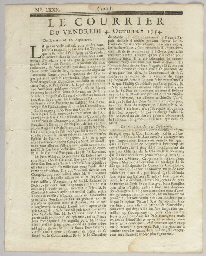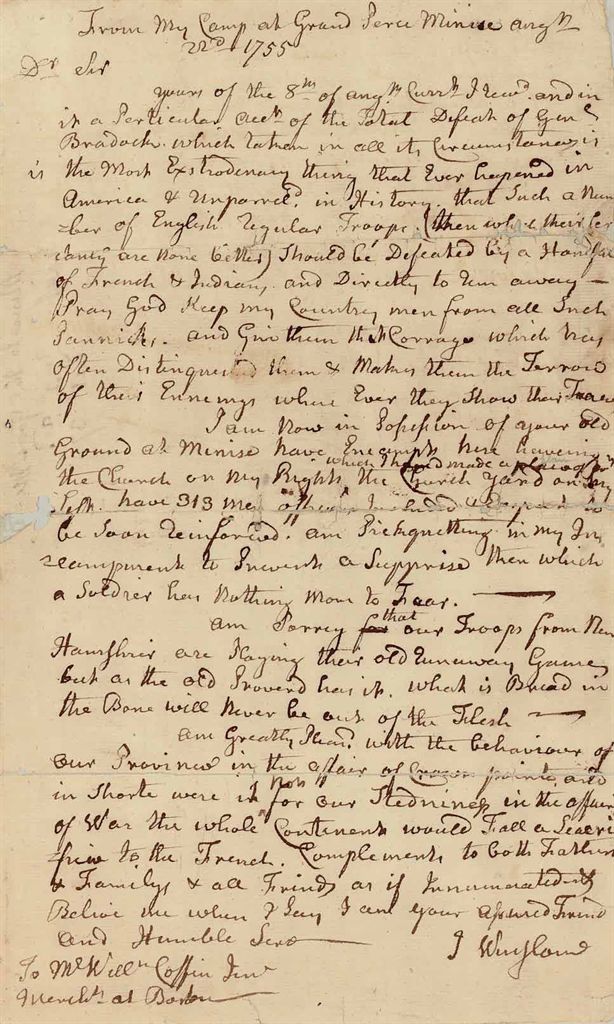14" length, triple raised ring with smooth spout, engraved with forts and Royal Coat of Arms. This well-travelled map horn shows every fort from New York to Fort Pitt at the Three Rivers. Wood base and iron carrying staple. While the owner is unknown, the horn has a historic connection to the Forbes Trail that solidified British dominance in the Ohio Territory following the ejection of the French. This extraordinary engraved map horn depicts the sequential forts and way points on the trail from Colonial New York to remote Fort Pitt (Pittsburgh) at the strategic Forks of the Ohio. The track departing from the frontier post of Carlisle is the path of the famed "Forbes Road" built by an army of 5,000 British regulars and Colonial militia under the direction of General John Forbes (1707-1759). Following the death of General Braddock during the ill-fated expedition against Ft. Duquesne in 1755, Forbes took command of British forces and commenced building a more direct road through 200 miles of trackless wilderness to attack the French at the strategic Forks. Hewn by hand from the primeval forest, the Forbes Trail was 20 foot wide and traversed the Allegheny Mountains with fortified supply posts (Raystown and Ligonier) at supporting intervals. The rough road was sufficient to support wagons and artillery and was completed in November 1758. The British advance column was attacked and bloodily repulsed on September 15, 1758 causing Forbes to immediately halt operations against Fort Dusquesne. Later in the fall the French at Fort Frontenac were forced to surrender leaving Fort Dusquesne with a much reduced garrison as their fickled Indian allies melted away. The sudden appearance of a large force of Redcoats emerging from the forest gloom so intimidated the few remaining French regulars that Fort Duquesne was burned to the ground and quickly abandoned. Forbes took control of the illusive prize on November 25, 1758 and ordered the post rebuilt naming it Fort Pitt in honor of his mentor William Pitt the Elder, British Secretary of State. Gravely ill through most of the grueling march, Forbes soon returned to Philadelphia where he died on March 11, 1759. Tracing Forbes' route the principal points are as follows: Fort Edward, Fort Stanwix, Crown Point, Fort Henry, Fort Carillon, R. Blockhouse, Mcniel, H.A. Moon, Albany, Philadelphia, Lancaster, Shapsburg, Carlisle, York, Loundon, and Bedford. The horn was likely carved and carried shortly after the construction of the new fort by a participant of the Forbes expedition as the names and locations generally correspond to the names known in 1758 culminating, of course, with Ft Pitt. Today parts of the Pennsylvania Turnpike and US Route 30 parallel the old Forbes Trail with key road markers westbound in Bedford and Westmorland County. As well as commemorating the Forbes Road and the ultimate capture of Ft. Duquesne, it is appealing to think of this historic horn in practical terms as a sort of portable road map anticipating the thrust of future frontier travel. Of course, the major significance of the Forbes Road in the decades following the French & Indian War was as a major land route into the heart of the prime Ohio country connecting Philadelphia and Pittsburgh. Condition: Very good. Nice even patina overall.
14" length, triple raised ring with smooth spout, engraved with forts and Royal Coat of Arms. This well-travelled map horn shows every fort from New York to Fort Pitt at the Three Rivers. Wood base and iron carrying staple. While the owner is unknown, the horn has a historic connection to the Forbes Trail that solidified British dominance in the Ohio Territory following the ejection of the French. This extraordinary engraved map horn depicts the sequential forts and way points on the trail from Colonial New York to remote Fort Pitt (Pittsburgh) at the strategic Forks of the Ohio. The track departing from the frontier post of Carlisle is the path of the famed "Forbes Road" built by an army of 5,000 British regulars and Colonial militia under the direction of General John Forbes (1707-1759). Following the death of General Braddock during the ill-fated expedition against Ft. Duquesne in 1755, Forbes took command of British forces and commenced building a more direct road through 200 miles of trackless wilderness to attack the French at the strategic Forks. Hewn by hand from the primeval forest, the Forbes Trail was 20 foot wide and traversed the Allegheny Mountains with fortified supply posts (Raystown and Ligonier) at supporting intervals. The rough road was sufficient to support wagons and artillery and was completed in November 1758. The British advance column was attacked and bloodily repulsed on September 15, 1758 causing Forbes to immediately halt operations against Fort Dusquesne. Later in the fall the French at Fort Frontenac were forced to surrender leaving Fort Dusquesne with a much reduced garrison as their fickled Indian allies melted away. The sudden appearance of a large force of Redcoats emerging from the forest gloom so intimidated the few remaining French regulars that Fort Duquesne was burned to the ground and quickly abandoned. Forbes took control of the illusive prize on November 25, 1758 and ordered the post rebuilt naming it Fort Pitt in honor of his mentor William Pitt the Elder, British Secretary of State. Gravely ill through most of the grueling march, Forbes soon returned to Philadelphia where he died on March 11, 1759. Tracing Forbes' route the principal points are as follows: Fort Edward, Fort Stanwix, Crown Point, Fort Henry, Fort Carillon, R. Blockhouse, Mcniel, H.A. Moon, Albany, Philadelphia, Lancaster, Shapsburg, Carlisle, York, Loundon, and Bedford. The horn was likely carved and carried shortly after the construction of the new fort by a participant of the Forbes expedition as the names and locations generally correspond to the names known in 1758 culminating, of course, with Ft Pitt. Today parts of the Pennsylvania Turnpike and US Route 30 parallel the old Forbes Trail with key road markers westbound in Bedford and Westmorland County. As well as commemorating the Forbes Road and the ultimate capture of Ft. Duquesne, it is appealing to think of this historic horn in practical terms as a sort of portable road map anticipating the thrust of future frontier travel. Of course, the major significance of the Forbes Road in the decades following the French & Indian War was as a major land route into the heart of the prime Ohio country connecting Philadelphia and Pittsburgh. Condition: Very good. Nice even patina overall.







.jpg)







Try LotSearch and its premium features for 7 days - without any costs!
Be notified automatically about new items in upcoming auctions.
Create an alert